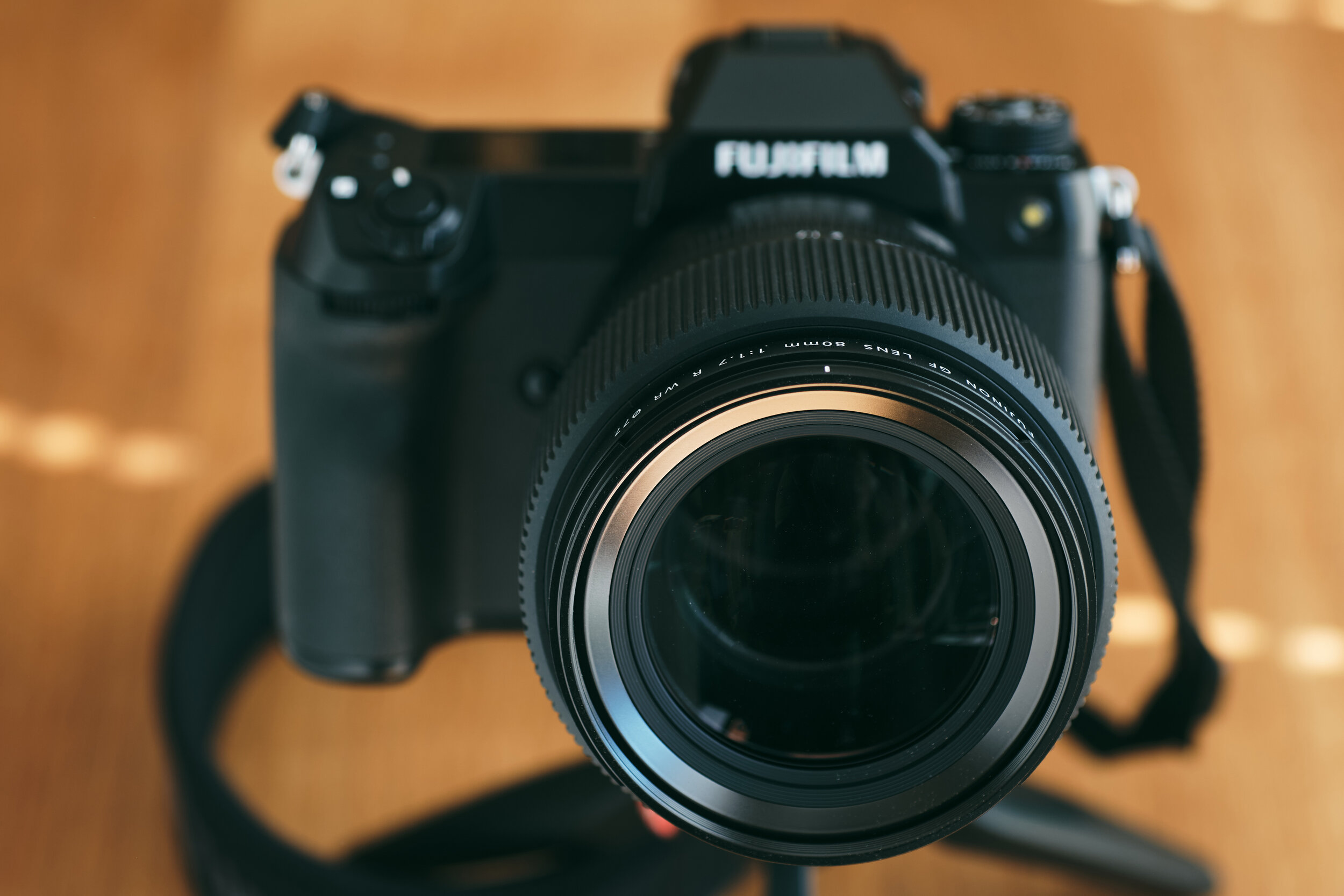Fujifilm GF 80mm f/1.7 R WR Review

The GF 80mm f/1.7 R WR shown on the Fujifilm GFX 100S
Fuji GF 80mm f/1.7 R WR Review
When I reviewed the Fujifilm GFX 50R about a year and a half ago I tested it with the GF 110mm f/2 R LM WR. I will get into the differences below but my main wish at the time was for a similar lens to the 110mm and with a slightly shorter focal length, with less bulk and weight. I thought a GF 90mm f/2 R WR would fit the bill.
In January 2021, this wish came close to reality when Fujifilm launched the GF 80mm f/1.7 R WR. With a full-frame focal length equivalent of 63mm, this new GF lens is closer to a standard focal length. I took it for a spin over the Easter long weekend while testing the Fujifilm GFX 100S.
The GF 80mm f/1.7 R WR shown on the Fujifilm GFX 100S
Fujifilm GF 80mm f/1.7 R WR - Introduction
For prime shooters, the GF 80mm f/1.7 was highly anticipated and the gap between 63mm and 100mm has now been closed with the fastest lens in the GFX system sporting the f/1.7 f-stop.
The GF 80mm f/1.7 is very reminiscent of the GF 110mm f/2 R LM WR and is almost a cloned copy, only smaller whereas it differs significantly from the GF 63mm f/2.8 R WR. So what is the GF 80mm f/1.7 R WR? Is it a portrait lens only or is it an all-around great standard lens?
The GF 80mm f/1.7 R WR is currently listed at $2,299.00.
West 41st Ave Bus Stop, Vancouver. Fujifilm GFX 100S, GF 80mm f/1.7 R WR @ f2
GF 80mm f/1.7 R WR - Handling and Specs
At 1.7 lb / 795 g, the GF 80mm is a gorgeous chunk of glass. The front filter diameter is 77mm but I would have guessed it to be larger at first glance. It measures 3.7 x 3.9" or 94.7 x 99.2 mm and it feels very substantial in size on the GFX 100S. The excellent grip on the GFX 100S, however, ensures a very solid grip on things.
I have used a Canon EF 85mm f/1.2L II for years on various 5D cameras and it was a bit of a déjà vu grabbing the GF 80mm and GFX 100S as this combination is very similar in size and weight, the Canon 85L actually being over 200g heavier but a tad shorter.
The GF 80mm f/1.7 R WR shown on the Fujifilm GFX 100S
The 9 rounded diaphragm blades should ensure nice-looking bokeh. The lens has 12 elements in 9 groups with two super ED elements. The minimum focus distance is 2.3' or 70 cm.
The overall feel of the lens is nothing short of top-notch and it should last you for decades. The lens hood clicks into place without any kind of wobble which is nice.
The aperture ring is of the finest quality I have encountered on any Fujinon lens. The clicks are dampened to perfection and can be changed with just the right amount of effort and the aperture ring should not easily be moved inadvertently.
Fujifilm GF 80mm f/1.7 in Action
After switching to the X Series cameras and lenses I am not used to lugging around heavy gear. The combination of the GFX 100S and GF 80mm f/1.7 adds up to 3.7 lbs, 1.695 g. While this may be considered lightweight in the GFX world it still bothered me when carrying it around town.
I know I should just get past this as it is not an apples-to-apples comparison but felt it was worth mentioning. If you were to use this lens in a studio setting or on-site photo sessions this will most likely be less of an issue.
Art Gallery Plaza, Vancouver. Fujifilm GFX 100S, GF 80mm f/1.7 R WR @ f2
I took the Fujifilm GF 80mm f/1.7 R WR out for some street photography in Vancouver and found the focal length very useful.
At the 63mm full-frame equivalent it feels just like a standard lens where you emphasize more on the topic at hand by having a slightly longer than 50mm crop. The actual focal length of 80mm ensures a slight telephoto compression without it being overly pronounced.
I certainly felt an improvement in regard to autofocus from my first GFX encounter with the GFX 50R. I even managed to nail a couple of shots of skateboarders at the Vancouver Art Gallery. I have described this further in my GFX 100S Review.
Fujifilm GF 80mm f/1.7 R WR - Portrait Session
Joel met me for a quick portrait session outside. I think many photographers will be eying out the GF 80mm f/1.7 R WR for portrait photography and rightfully so. This was a quick session shot with natural light and a white reflector with a shifting cloud cover.
I do think the GF 80mm f/1.7 rendered pleasing images. I shot a variety of f-stops in the f/1.7 to f/2.8 range. The larger sensor coupled with excellent optics makes a beautiful transition of bokeh.
It is not as abrupt as you may experience on APS-C from time to time. If you zoom in to 100% the images are painstakingly sharp. The four photos below were shot at f/2.5, f/1.7, f/2, and f/1.7.
I thought it would be fun to throw in a few portrait images to see how they would stack up with images captured on the GFX 100S and the GF 80mm f/1.7 R WR.
These photos are from former sessions and with various camera/lens combinations and lighting conditions. I know it is not a scientific approach but I wanted to show a few photos to see if we can see any meaningful difference in what you can hope to create with different tools.
The first photo was captured on a Canon 5DSR full-frame camera with a Canon EF 85mm f/1.2L Mark II lens, the second with an XF 56mm f/1.2 R on Fujifilm X series APS-C, and finally the third, an XF 90mm f/2 R LM WR on Fujifilm X Series APS-C. Please see the EXIF info below the photos.
Jordan, Canon 5DSR, Canon EF 85mm f/1.2 II @ f/2. Light source: off camera Canon Speedlite in a small soft-box
Mik, Fujifilm X-Pro2, XF 56mm f/1.2 R @ f2. Natural light reflected from a soft-box liner
Linda, Fujifilm X-Pro2, XF 90mm f/2 R LM WR @ f/2.2. All natural light, no reflector used.
Fujifilm GF 80mm f/1.7 R WR - Image Quality
There are five contributing factors making up for the excellent image quality that you can expect from the GF 80mm f/1.7 R WR.
I see it as a combination of the impressive 102-megapixel sensor in the GFX 100S, the optical formula in the lens, Fujifilm’s image processing and film simulations, and how well it all plays out in Capture One with post-processing. Finally, let’s not forget about the person behind the camera :)
The end result is a very film-like experience, especially when using the new Nostalgic Negative film simulation. While the GF 80mm f/1.7 delivers sharp images the photos do not appear clinically sharp but instead ooze a pleasing character.
Fujifilm GFX 100S, GF 80mm f/1.7 R WR @ f2.8
Fujifilm GF 80mm f/1.7 vs. GF 110mm f/2
Recently the GF 110mm f/2 R LM WR has been on sale with a $500.00 discount making it exactly the same price as the GF 80mm f/1.7 R WR. The discount will end on April 18th, a couple of days after the publish date of this review, so please check if the sale is extended.
The price difference naturally will play into your decision but here are a few other factors to consider. At 2.22 lb / 1010 g, 3.71 x 4.94" / 94.3 x 125.5 mm, the GF 110mm is a bigger lens and the telephoto effect will be significantly more pronounced at 110mm. This equates to about an 85mm field of view in full-frame terms.
Fisherman’s Wharf, False Creek, Fujifilm GFX 100S, GF 80mm f/1.7 R WR @ f1.7
Picking one over the other would be a very personal choice and would depend immensely on which other lenses you may have. Both lenses are top-notch.
The GF 110mm perhaps renders a more clinically sharp image to my eye but may lack some of the characteristics of the GF 80mm f/1.7. Keep in mind, I base this on limited testing over a few days and I have tested on two different cameras.
You will be able to create stunning images with both. The GF 110mm is a more classic portrait focal length whereas the GF 80mm in my opinion is more versatile.
If I was to start a GFX setup from scratch I would probably pick the GF 80mm f/1.7 R WR due to its versatility, less bulk/weight, and lower price tag. Below I will post two portraits, one from the GF 80mm and one from the GF 110mm.
You can read my GF 110mm f/2 R LM WR review here:
Joel, Fujifilm GFX 100S, GF 80mm f/1.7 R @ f/1.7
Mik, Fujifilm GFX 50R, GF 110mm f/2 R LM WR @ f/2
Fujifilm GF 80mm f/1.7 vs. GF 63mm f/2.8
At $1.499.00, 14.29 oz / 405 g with dimensions of 3.31 x 2.8" / 84 x 71 mm, the GF 63mm f/2.8 R WR is much easier to handle. That goes for your wallet as well as your back. But how does it compare to the GF 80mm f/1.7?
The build quality of the GF 63mm is a bit of a letdown. It does not feel as sturdy. The autofocus has an audible sound and the overall feel of the lens will fall short in comparison with the GF 80mm f/1.7. The price difference, in my opinion, should be more than $800.00.
With that said I enjoyed the images produced by the GF 63mm f/2.8 R WR and it is the de facto standard lens that nicely shows the difference in image quality when making the jump to a 44 x 33 mm sensor.
I still wish for a GF 63mm f/2 version with similar quality as the GF 80mm f/1.7 but until that happens, and I do not know if it will, the GF 80mm sits strongly in this focal length range.
The GF 63mm would still be a great lens for entering the GFX system, especially if you can find a used copy. Below are two street images, one from the GF 80mm and one from the GF 63mm.
You can read my GF 63mm f/2.8 review here:
Vancouver, Fujifilm GFX 100S, GF 80mm f/1.7 R WR @ f2.8
Vancouver, Fujifilm GFX 50R, GF 63mm f/2.8 R WR @ f/5.6
Conclusion
At $2,299.00, the GF 80mm f/1.7 R WR is a substantial investment and when spending your hard-earned cash you want to be sure you get plenty of value in return.
If you are a pro photographer the GF 80mm f/1.7 R WR is in the category of products that can set your work apart. It is a solidly built lens and is likely to give you a satisfying feeling whenever you bring it to a gig.
The GF 80mm f/1.7 R WR shown on the Fujifilm GFX 100S
You do have to decide if the 80mm focal length is right for you and I hope my sample images give you somewhat of an idea of what to expect.
I think it would be wrong to label the GF 80mm as a portrait lens only. This lens can of course be used for anything from landscapes to documentary, or still-life photography. I would not go as far as giving it my stamp for action photography.
In closing, I cannot help but wonder how much smaller the GF 80mm f/1.7 would have been if they had made it an f/2 lens instead of f/1.7 but then I see the Hasselblad XCD 80mm F/1.9 is slightly longer, and about 8.8 oz, 250 g, heavier so perhaps I should back off of the bulk/weight issue, eat more spinach, and just be happy :)
Pros
Phenomenal build quality
Weather Resistant
Excellent image quality
Wonderful boheh
Cons
Lacks the linear motor seen in the GF 110mm f/2
Please see more sample images below.
Price / Availability
Thank you for reading my review. If you are planning a purchase and would like to support us, you can do so, at no additional cost, by using the affiliate link below. A small commission goes to us and helps us keep the wheels turning at 5050 Travelog.
Check the current price at B&H Photo
Fujifilm GF 80mm f/1.7 R WR - B&H Photo
Thank you for being supportive.
Fujifilm GF 80mm f/1.7 R WR - Sample Images
Please see the sample images below. Editing was done in Capture One and I used Fujifilm film simulations for some of the photos, especially Nostalgic Neg. and Acros.
Please click to view larger images.
Nelson Park, Vancouver, Fujifilm GFX 100S, GF 80mm f/1.7 R WR @ f/2
Nelson Street, Vancouver, Fujifilm GFX 100S, GF 80mm f/1.7 R WR @ f/2.8
Victoria Drive, Vancouver, Fujifilm GFX 100S, GF 80mm f/1.7 R WR @ f/1.7
Burrard Street, Vancouver, Fujifilm GFX 100S, GF 80mm f/1.7 R WR @ f/4
Robson Square, Vancouver, Fujifilm GFX 100S, GF 80mm f/1.7 R WR @ f/5.6
Art Gallery Plaza, Vancouver, Fujifilm GFX 100S, GF 80mm f/1.7 R WR @ f/2.5
Downtown, Vancouver, Fujifilm GFX 100S, GF 80mm f/1.7 R WR @ f/2.8
False Creek, Vancouver, Fujifilm GFX 100S, GF 80mm f/1.7 R WR @ f/8
Creekside Park, Vancouver, Fujifilm GFX 100S, GF 80mm f/1.7 R WR @ f/4
Fisherman’s Wharf, Vancouver, Fujifilm GFX 100S, GF 80mm f/1.7 R WR @ f/11
Staley Park, Vancouver, Fujifilm GFX 100S, GF 80mm f/1.7 R WR @ f/8
Coal Harbour, Vancouver, Fujifilm GFX 100S, GF 80mm f/1.7 R WR @ f/8
Stanley Park, Vancouver, Fujifilm GFX 100S, GF 80mm f/1.7 R WR @ f/8
Victoria Drive, Vancouver, Fujifilm GFX 100S, GF 80mm f/1.7 R WR @ f/5.6
Victoria Drive, Vancouver, Fujifilm GFX 100S, GF 80mm f/1.7 R WR @ f/1.7
West 41st Ave., Vancouver, Fujifilm GFX 100S, GF 80mm f/1.7 R WR @ f/3.6
Wreck Beach, Vancouver, Fujifilm GFX 100S, GF 80mm f/1.7 R WR @ f/1.7
Wreck Beach, Vancouver, Fujifilm GFX 100S, GF 80mm f/1.7 R WR @ f/1.7
Fujifilm GFX Reviews
Fujifilm GFX 100 II
Fujifilm GFX 100S
Fujifilm GFX 50S II
Fujifilm GFX 50R
Fujifilm GFX 50R in 2022
Fujifilm GF 20-35mm f/4 R WR
Fujifilm GF 23mm f/4 R LM WR
Fujifilm GF 30mm f/3.5 R WR
Fujifilm GF 32-64mm f/4 R WR
Fujifilm GF 35-70mm f/4.5-5.6 WR
Fujifilm GF 45mm f/2.8 R WR
Fujifilm GF 45-100mm f/4 R LM OIS WR
Fujifilm GF 50mm f/3.5 R LM WR
Fujifilm GF 50mm f/3.5 - Revisited
Fujifilm GF 63mm f/2.8 R WR
Fujifilm GF 80mm f/1.7 R WR
Fujifilm GF 110mm f/2 R LM WR
Fujifilm GF 100-200mm f/5.6 R LM OIS WR
Fujifilm GF 250mm f/4 R LM OIS WR
See all of my reviews at a glance: Camera Reviews - Archives






